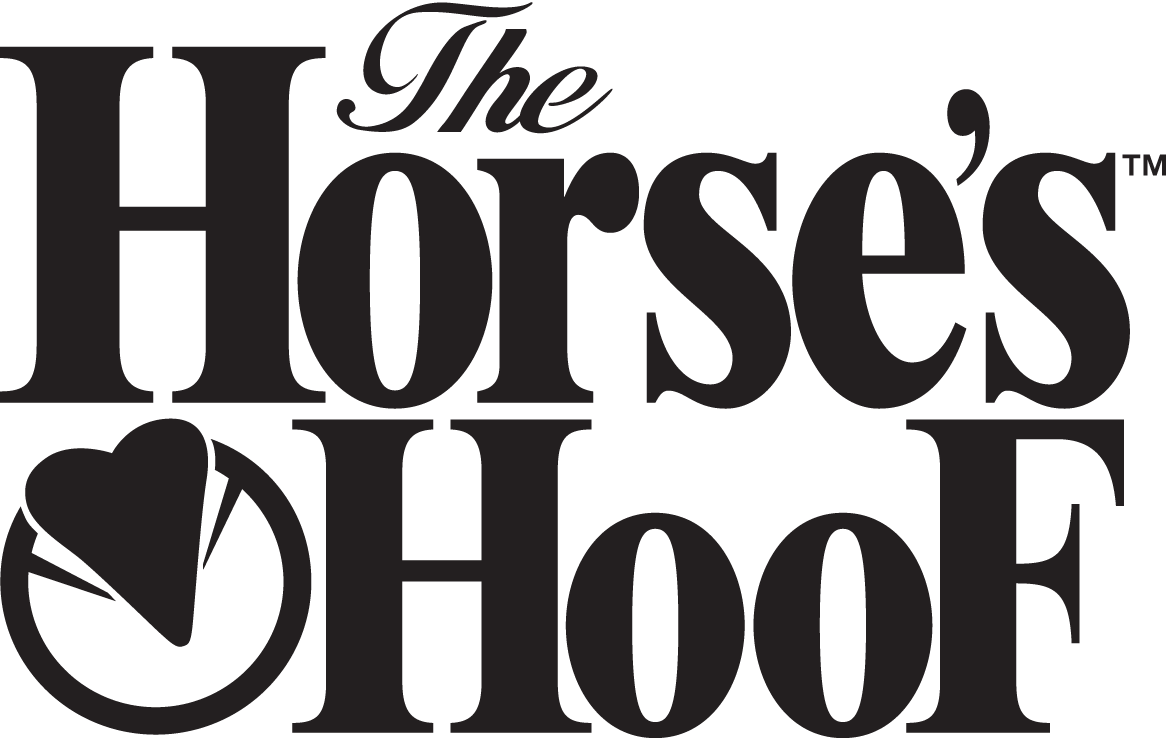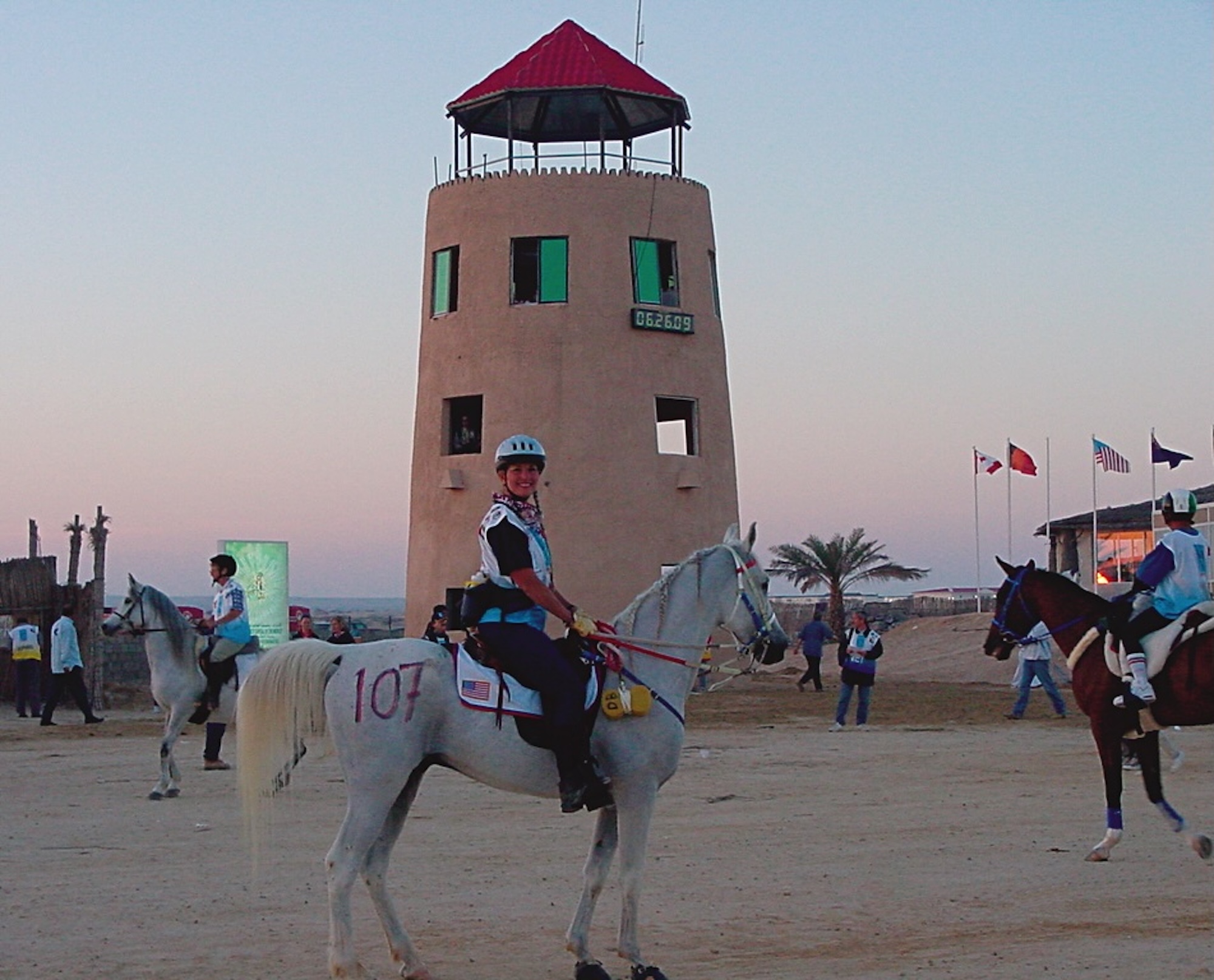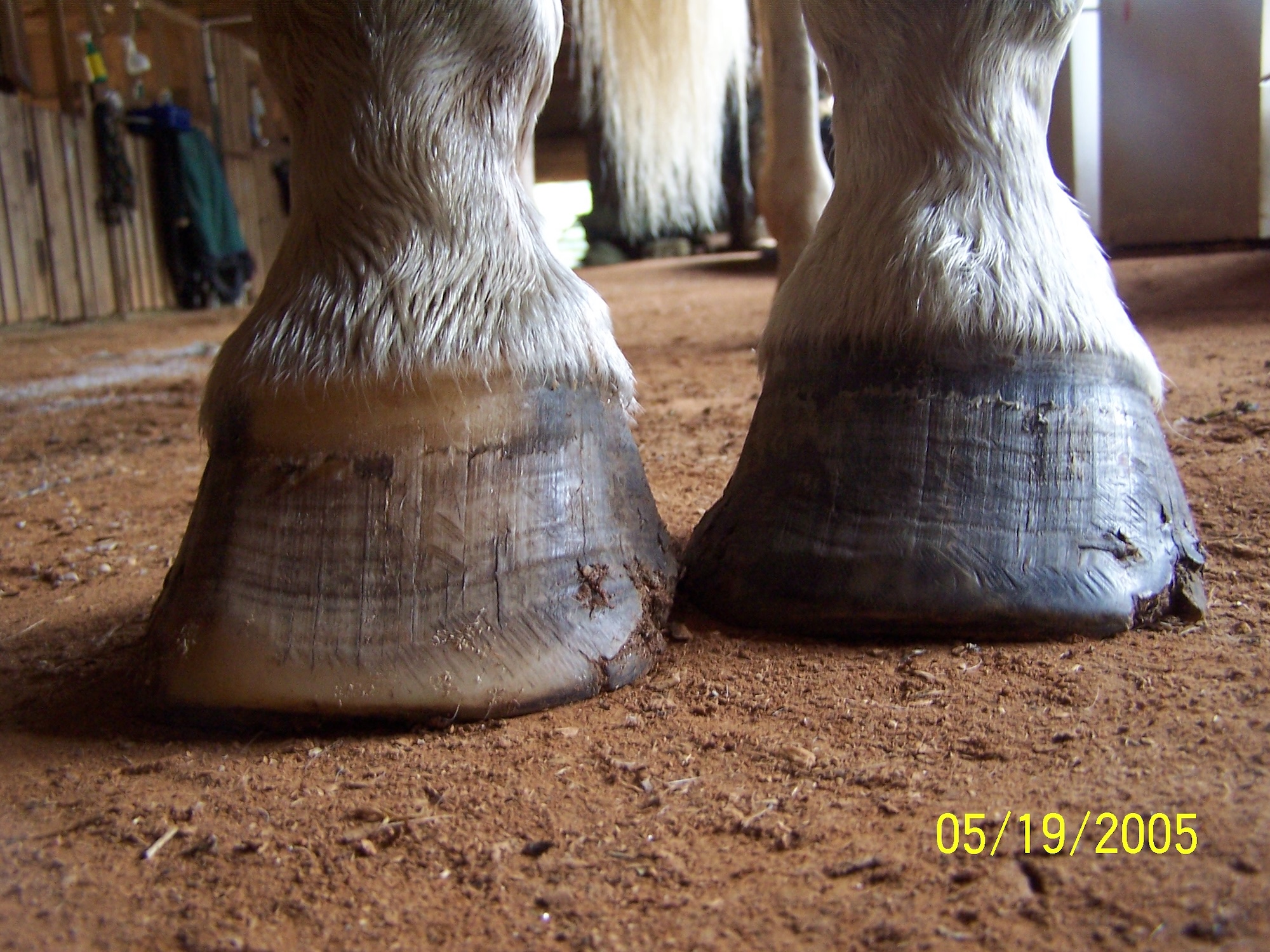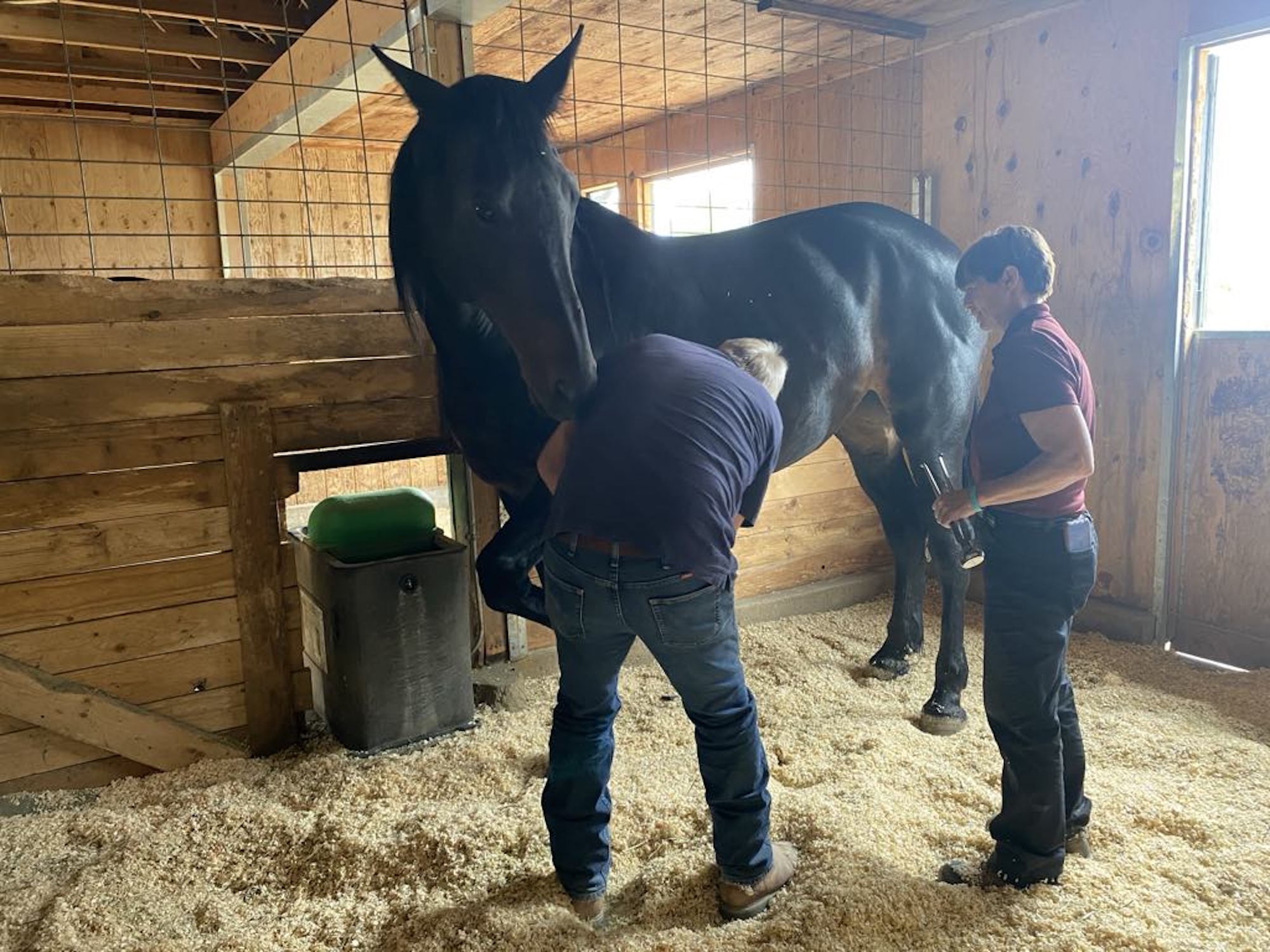An extreme “challenge” is certainly not going to scare off Darolyn Butler-Dial. After all, her 3rd endurance race, in 1981, was the 100-mile Tevis Cup! This four-time national endurance champion now has over 20,000 miles of competition behind her, including US team and international competitions.
If anyone thinks that top level endurance horses can’t race barefoot, Darolyn is prepared to prove that idea wrong. Training and competing barefoot endurance horses involves its own unique challenges, but she is ready for the task. Says Darolyn, “I have been running ‘barefoot’ only since last November [2000], but am having a great time doing it, and loving every minute of it. My 1st to Finish record may have slowed a bit, but my pride in ‘To Finish is To Win’ has changed to ‘To Finish Barefoot, is to Win’.”

Darolyn practices her trimming skills on a cadaver hoof at Dr. Strasser’s 2001 Florida Seminar.
Darolyn was introduced to the concept of barefoot performance horses through clinics with Martha Olivo in the fall of 2000. Through Martha, she then learned about Dr. Hiltrud Strasser’s trimming techniques and recommendations for horses’ living conditions.
Darolyn has now de-shod all of her farm’s 40 horses, including six National Champions, one that went to the World Championships in France and another that competed in the World Cup in Dubai in March 2001. “I’m doing all my own trimming (Strasser Style). I didn’t think I would be learning this kind of a skill at age 51, but here I am doing it. I hope I don’t sound like I’m bragging when I say, I’m the best trimmer on the farm!”
Although the general recommendations are to take it easy on newly de-shod horses while the old hoof wall is growing out, Darolyn was able to go just a little further and get away with it. “I trimmed one horse on Thursday, Dec. 28th, ran him in a 50-mile race on soft ground on Dec. 30, ran another 50 (fairly soft ground) on Jan. 14 and ran a 100 on Feb. 3rd. The first 20 miles of the 100 were really nasty rock on hard cliche road, so I used boots on the front, barefoot in back for that portion of the race only. We finished two farm horses barefoot that day in the 100 mile. I don’t recommend others starting them that quick, but it worked out okay for me.”
And worked out it has – Darolyn’s barefoot horses have competed extensively in 2001. A compilation of data from published AERC records reveals incredible results for Darolyn’s barefoot competitors: (47) 50-milers with only 10 pulls (79% completion rate), and (4) 100-milers with 1 pull (75% completion rate). Since these statistics were put together using DBJ named horses, actual figures are probably even higher when you include the barefoot horses whose names do not contain the DBJ prefix.
At the recent Unicorn Hunt Ride in east Texas, Darolyn’s daughter Ceci won the 50 on DJB Raad Bey, the horse that had a light case of laminitis in Sept. 2000, and got Darolyn first started on the barefoot road. And the victory line-up continues, with 2, 3, 4, 5, 6, 7, 8, and Best Condition all going to barefoot horses, all of them Darolyn’s except 4th place was David Kaden, who does his own trimming. That’s right, 8 out of the 10 Top Ten were barefoot!
What about support from the ride managers and vets, who have the final say on whether a horse can compete without shoes? Darolyn says their response has been positive: “The ride vets in my area have been very interested and supportive regarding the barefoot horses. The ride managers too—they make a special point in letting us know the footing prior to the race so we know how we want to address the hooves. I have made an error in judgment, and I’m not beyond shoeing or booting in mid-race if I need too. Once again, it’s the horse’s welfare I’m interested in, not proving a point.”
Darolyn’s biggest obstacle so far has been the lack of rocky ground to train on. Her horses live and condition in the soft, sandy ground near Houston, Texas. While she tries to find ways to improve their ground condition, meanwhile she must be careful about rocky rides. Darolyn comments, “I have no rocks or really hard surfaces to train on, so my horses have a distinct disadvantage when they do have to compete on the rocks. I use either boots or shoes depending on the horse and/or the importance of the race. I remove the boots and shoes as quickly as I can after the competition, in order that I don’t harm the fragile hoof any more than I have to.”

Above: Darolyn and DJB Chaser at the start of the 2001 World Cup in Dubai on March 22nd, 2001. They pulled out of the race due to a suspensory problem, but Chaser’s bare feet (below) were healthy and strong. Chaser’s hooves in excellent condition in Dubai. Photos courtesy Darolyn Butler.


Darolyn is thrilled with her experiences with barefootedness. “I feel like I’m truly getting soundness results in chronically lame (club footed) horses. I’m taking those heels down and getting incredible results. Horses that used to refuse to take both leads are now choosing alternating leads with no problem. Hooves that were so shelly and thin they wouldn’t hold a shoe without acrylic and clips, now have hoof walls thick and strong! Even older horses off the track, that have worn shoes for 10-12 years, are making unbelievable turn-arounds in their hooves’ health and condition.”

Darolyn Butler-Dial was one of only five US competitors invited to participant in the 2001 FEI/UAE World Cup Endurance Ride in Dubai. Darolyn rode her 14 year old barefoot grey Arabian gelding, DJB Chaser. There were plenty of camels in Dubai!
World Cup in Dubai, March 2001 by Darolyn Butler
By the time we got to Dubai, because of all the shipping time, it had been close to a week since my horse DJB Chasar had been soaked. Remember, for the “trim” to be successful, three things have to be present: 1) the correct physiological trim, 2) 24/7 natural turn out, 3) Feet wet daily. I had trimmed him just before I loaded him in the van, thinking I would not even trim him again before the race three weeks later. I figured I needed all the natural growth I would get in the next three weeks, but that wasn’t true.
Exercise Day #1 UAE: That day, I did not use the Horsneaker® Hoof Boots that had been foam fitted and custom-made for Chaser. Our exercise trail was on a pretty hard and rocky road. We came in with a little chipping, not bad, but if it keeps up there won’t be any foot left. I’m concerned. The next day, the same thing, so I started trying to figure out how to soak him. I tried a big pan, but it was a bit awkward and time consuming. Then I noticed how much water all seven horses in our barn used for washing anyway, so I dug a shallow pit (we called it Chaser’s Pond) right at the drainage edge of the concrete wash rack. It stayed damp, if not full, most of the time just from the barn run-off. I would put him in it to feed him both morning and evening on most days for 15 to 30 minutes. He stopped chipping immediately, and I also stayed more in the dunes (and off the hard road) for conditioning as well. The soaking did the trick. Chipping stopped immediately and feet became more pliable and strong. The salt in the sand, plus the drying heat, coupled with the soaking was a perfect combination. His feet became harder, yet maintained elasticity, every day. Chipping stopped and the feet looked beautiful and started growing. Amazing. Every two or three days, since I had the time, I fussed with them. In fact, it was wonderful to be able to devote yourself to one horse and his feet instead of being distracted by 39 other horses.
We could be with the horses from 8 am to noon, and 2 pm to 6 pm everyday. Since they were stalled on concrete the rest of the time, we all tried to either ride, walk or turn the horses out during this time as much as we could. In agreement with the science of the trim, I kept him pretty much bare on the concrete, with a pile of shavings in the corner for him to lay on at night, or for urination. I’m sure that caused some whispered conversations as everyone else had bedding a foot deep in their stalls.
I’m sure everyone thought that the barefoot thing took lots of time, but I was just so curious and the daily changes were incredible, so it was fun to observe and watch the hooves daily. The bars kept dropping and I was even taking a bit of toe off on some days. I continued to concave a bit from time to time, too.
Still concerned about the rocky road, I decided I needed to try out the Horsneaker® Boots to see how they worked. Unfortunately, the deep sand filled them up and caused the strap in the back to rub under his fetlock. I sent a quick fax to the US to the company and requested another front set WITH HOLES in the sole. The darling chef at our abode kindly burned holes in the set I had with me. That helped; the sand then drained back out of the boot as it came in.
Still, I was a little nervous about the slight rub, and I didn’t want to train in them any more, in case they continued to rub. Sentiment in the barn was mixed. Some had no opinion, others were encouraging me to shoe, and others were supporting the barefoot regimen.
Jay (Valerie’s farrier) was a prince. He checked all the horses’ feet & legs everyday after he got there. I must say I was sweating his opinion and judgment, but he was quite gracious and eternally helpful in looking at how I was doing in balancing the foot. The front feet were ok, but the back feet became “PERFECTLY BEAUTIFUL”—the ideal “barefoot”—hard walls, concavity, low heels and balance. I knew that I could run barefoot in the back at least. I was holding out on the final decision on the fronts until closer to race day.
Now I must tell everyone how horrible this horse’s feet had been. He had been a flat track race horse all of his life. In fact, he holds the AJC record for number of races started. He was 12 when I bought him, and had lived in a stall at a race track for most of his adult life. His hoof walls were so thin and shelly, we had to use acrylic to build his foot enough to shoe him, and always shod with clips for that extra edge. Still, it was not unusual for him to drop a shoe in a competition. I figured him for the most unlikely candidate for a natural trim. Was I ever surprised!
Three days before race day there was some swelling above his ankle. I had worked pretty hard in the sand the day before, plus I was stressing about whether to take his “high heel” down some more. I didn’t want to make any radical changes, but in retrospect, I think I should have taken it down a little more. He was just landing too flat on it, and I think the concussion is what was aggravating that suspensory. We iced, applied magnets and lasers, and it went down by the next day. Race jitters had set in.
Vet Check Day: He looked great! Trotted out barefoot, and everyone commented on how nice and big his trot was. I drove the course in a Land Rover. With dismay I noticed the last 1.5 miles of the last two loops (which were the same) were strewn with big, nasty gravel rocks. The dunes were soft and high on either side of this road, with no place to go, but deep sand or the gravel. He could handle hard road, and even the asphalt was not a problem—big gravel rocks were. So now I was debating the use of the Horsneaker® Boots or Easyboots, or SHOES. I really hated to aggravate whatever might be going on with the suspensory with the weight of the shoes, so I opted to wear the Horsneaker® Boots.
Race Day: Horse is readied, Horsneaker® Boots put on. Ride starts. I’m way back, just like I intended, actually even further back than intended—but Chaser’s out to change that.
I had devised a Indian bridle for him while over there that really had worked well during training. Just a loop around his lower jaw. I rigged up a “barn made” version of some draw reins. This horse is very, very sensitive behind the ears, a true maniac to hold, especially if there is pressure behind the ears. This way I had control and no pressure on his poll. He loved it. We trained in it every day and he was quite manageable. However, I did not race in it because draw reins are illegal in FEI rides.
I was riding with a Linda Tellington-Jones TTeam bit—it’s a long shank, high port with roller and chain chin strap, and double reins. It’s a powerful bit, both in the mouth and pressure at the poll, and I was having to really pull back. So I was looking down fussing with the four reins, making sure they were even about halfway through the first loop, and looked up just in time to see Chaser getting ready to run over an 18″ piece of re-bar sticking up in the desert. Talk about a rock with our name on it.
The metal bloodied his knee and probably did the previously sore suspensory no good. We came into the first check in good shape. His pulse was in the 40’s, so we immediately walked into the check, much to my surprise. He trotted out well, but the vet requested I remove the Horsneaker® Boots, which I did. There was a small rub, which he suggested I attend to, and I put Desitin on it. My crew washed the boots, which may have been a mistake as I think it made them a little slick. They may not have fastened them on as tight as they should have upon my re-entering the track, as I lost both of them in about a mile of leaving the vet check. I opted not to stop to put them back on, as that loop was all sand with the asphalt finish. His feet looked fine after the loop, but the suspensory didn’t. He was definitely nodding on that high heel side. We were out. Fun while it lasted, but over way too soon.

DJB Oporto and Darolyn at the Biltmore Challenge 2001 100 Mile Race.
Barefootin’ Ahead
So now…to shoe or not to shoe? Where I am right now is still totally 100% belief that the barefoot trim is the right thing to do for all horses. If you cannot condition on hard ground and rocks, it will be very challenging to race on such ground barefoot, so you will have to have some sort of foot protection. Over the next year I plan to modify my feeding/watering area so I’m sure that they are getting soaked regularly, and also exposed to rough ground.
I love the “barefoot thing.” I honestly don’t believe that some of my horses would be as sound as they are if it wasn’t for the leveling up of their uneven hooves with the “barefoot trimming.” Now, the question is, what to do for foot protection when we live and train in a damp swamp here in Houston, TX. I will be talking with Frank Orza and Mary Winn (owners of Horsneaker®) and see if they have any additional thoughts or ideas. The Horsneaker® Boots are a good idea and probably work great for shorter and/or slower rides. But for difficult 100 Milers over sand, rocks and mud, there are problems. Hopefully Frank can come up with some new innovative ideas to improve both the fit and the durability for serious rides. They have been quite accommodating throughout, and I have no doubt they will continue to strive for the perfect hoof covering.
During the months of May, June and July (2001), we attended a few Texas rides. Marginal success at the one rocky ride, huge successes at the forest rides. 14 out of 16 farm horses completed Old Glory, 12 out of 14 at the recent Foxfire ride. All 40 horses on the farm are now barefooted and loving it. Even the horses that have been notoriously bad to shoe in the past are becoming fairly agreeable to trim.
We had a terrible stroke of bad luck in June (2001). A massive flood hit our place, and almost all of Houston, TX. During the evacuation of the horses, DJB Bronze Star and a pony were swept down the river. We found Bronze Star’s body several days later about 8 miles down stream. Bronze Star was one of 3 horses I had nominated for the Pan Am. He was a solid campaigner with near 2000 miles, and did his 1st race barefoot in Dec. ‘00, only a week after receiving his first “barefoot trim.” Two weeks later he ran another 50, (all on soft ground), then 3 weeks later a 100 on mixed rocky/hard/pasture trail. Then on April 7 he did our qualifying 100 ride on the same trail, Bluebonnet, and did great.
So the chosen one for Pan Am was DJB Oporto. He was almost as an unlikely “barefoot” prospect as Chaser, as he had a very chronic history of lameness due to his high/low heel syndrome. We had a long, but uneventful, trip to the Vermont, and after riding and examining the trails, decided it would be necessary to shoe. I hated to do it, but I just was not confident enough in any other product to risk it on a race of this magnitude. Although our coaches had not pressed me hard, I knew they were pushing me in that direction as well. Had a great race until 80 miles. Was pulled, to quote the vets, “too bouncy”—don’t ask, there is no answer. Oporto was trotting in extremely tall grass, and he’s an extremely sensitive horse. Even his own tail swishing against his legs will cause him to kick in many incidences. So, it’s pretty tough to be a good sport on this particular pull. Did the weight of the shoes create the extra action in the back? It’s hard to say.

DJB Albanet and Darolyn.
I’ve given many horses their first barefoot trim now. It’s akin to a religious experience to see such a catharsis in some feet. One lady brought a beautiful mare to me for a saddle fitting. I couldn’t keep my eyes off her feet. They were awful! Pigeon toed, unbalanced, ragged & long. You guessed it, I ended up trimming them. One hour later the mare walked much straighter and her feet were beautiful. However, the real reward was this last weekend when she won the 25 mile Best Condition Award at Foxfire. Barefoot, of course. An additional high for the day was Chaser winning the 50 Mile Ride. His first race since Dubai, he looked great, and all feet were “Bare Feet.”
by Yvonne Welz and Darolyn Butler, published in The Horse’s Hoof Magazine Issue 5, Fall 2001; and Issue 6, Winter 2002
Behind the Bridle: The Untold Story of Cypress Trails Ranch
https://www.youtube.com/watch?v=yG6D7VsId5g
Darolyn Butler’s links:
https://cypresstrailsranch.com
https://www.instagram.com/cypresstrailstx/
https://www.facebook.com/CypressTrails
See the full content listing of all issues of The Horse’s Hoof Magazine! We also provide instructions on how to read the issues for free on Hoof Help Online.
For a detailed listing of all articles on The Horse’s Hoof website, please visit our Article Directory.




